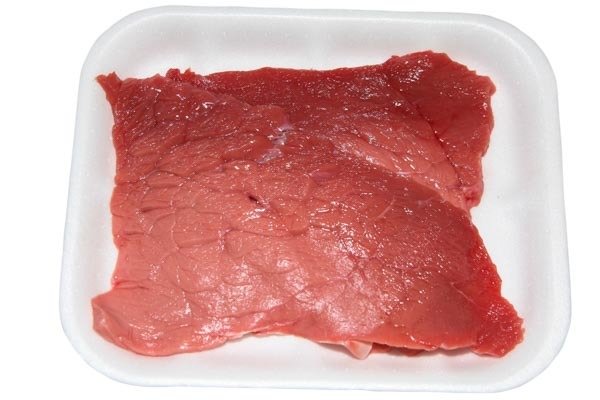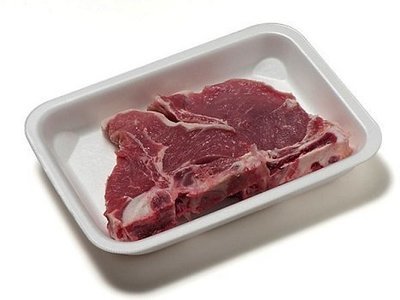VEAL SLICES CHOP RUMP 150g
VEAL SLICES CHOP RUMP 150g
With prime meat from the eye of the loin or rib, our off-bone chops have a rich, sweet flavour
The exact price for weight article arises only for non prepacked meat after the goods have been balanced. Therefore, there may be deviations from the purchase order price.
1. Blade
2. Shoulder
3. Rib
4. Loin
5. Sirloin
6. Boneless Rump
7. Round Steak
8. Leg (round)
9. Breast
10. Fore Shank
CUTS OF VEAL
Breast of Veal:
The breast of veal is not very tender and requires lengthy cooking. Best cooking method: Because it is bony, it can be cut into riblets and used as veal spareribs. It can also be made into a slow-cooked roast with bones left in, or boneless with a succulent stuffing
Centre Leg Roast:
This is exactly in front of the hind shank and just before the sirloin. The centre leg is an extremely tender roast with the bone left intact. Best cooking method: Roast.
Crown Roast of Veal:
The crown roast of veal is an elegant dinner party entrée that can be easily carved by the host. The rib chops are "Frenched", and then they are slightly cut and cracked at the bone so that they can be bent into a crown shape. Before roasting, the centre is filled with stuffing. Before serving, frills are often added to the top of the bones for a festive appearance and easier eating. Best cooking method: Roast
"Frenched" Rib Veal Chops:
Although this is the exact same meat as in a regular veal chop, it is trimmed quite a bit. The meat surrounding the bone is removed as in a crown roast, and these spare bones can be embellished with paper frills. Best cooking method: Broil, grill, pan grill
Hind saddle of Veal:
This consists of the sirloin, then the rump or leg, and ends with the hind shank. The tenderest portion is the rump (minus the hind shank). Best cooking method: This section makes a wonderful roast that can be complete with bones, or boneless and rolled. It can also be cut into delectable cutlets or thin slices for scaloppini.
Hind shank of Veal:
This is the cut to choose for ossobuco. It is more rugged than the foreshank, but a delight to the taste buds. Best cooking method: Braise or pot.
Kidney Veal Chops:
These chops are like the loin chops, but have the added attraction of a slice of veal kidney. The tail of the chop is wrapped around the kidney and then skewered. Best cooking method: Bake, grill or broil.
Loin of Veal:
The loin section lies right next to the sirloin and is the final cut of the hind saddle. We sometimes refer to this section as the porterhouse of veal. In a small calf, the loin is only about eight inches wide and can be cut into small roasts and chops. As the kidney is in this area of the calf, it is frequently part of the cuts. Best cooking method: Roast.
Loin Roast of Veal:
This is a V-shaped cut, like a number of uncut chops. We often crack the T-bone parts so that the carver can cut guest-size portions easily, just like chops. Best cooking method: Roast
Loin Veal Chops:
These chops are identified by their T-shaped bones. They have a large eye and a tenderloin. The tail is usually trimmed off. Best cooking method: Bake, grill or broil
Neck of Veal:
This is an inexpensive and tougher cut. Best cooking method: Stew. When boned, it can be ground for veal burgers
Rib of Veal:
Sometimes called the rack, this section comes right after the loin and is the first portion of the fore saddle. The first six bones of the rib are the most tender for either roasts or chops. Best cooking method: Roast
Rib Roast of Veal:
This roast looks like a series of rib chops. The chine and the feather bones have been removed for easy carving. Even though they are not cut from the outside, we usually crack the bone for easy carving. Best cooking method: Roast
Rib Veal Chops:
These chops are cut from the rib roast. Best cooking method: Broil, grill, pan grill
Rolled Double Sirloin Roast:
This roast is also called a double rump roast. All bones are removed from the complete sirloin and rump end. Then the roast is rolled. The rolled double sirloin roast is a wonderful concoction, easily carved by the host. Best cooking method: Roast
Rolled Leg:
Rolled Leg: This is the same as the centre leg roast, but it has been completely boned, rolled and tied.
Best cooking method: Roast
Rolled Loin Roast:
The rolled loin is the same as the loin roast, but with the bones removed. Before it is rolled and tied, it may be stuffed with veal kidney, or a bread stuffing. Best cooking method: Oven roast
Scaloppini:
Scaloppini is wafer-thin, and so delicate and fragile that we only cut it to order . never in advance. We use the intricate French style of preparation: first, we dissect the centre of the leg, demembrane it, and remove any sinewy fibres. We also use scaloppini from the more delicate loin area. The veal is then sliced to order, and pounded until it is paper-thin, or whatever thickness the customer specifies. This varies from one-eighth to one-quarter inch. Best cooking method: Sauté
Shank Half of Leg:
An excellent roast, but less tender than the centre leg roast. Best cooking method: Roast or braise
Shoulder of Veal:
Even though this forward section of the fore saddle is more fibrous and not as tender as the leg section, it has a lovely taste as a roast. These roasts can be cut with the bone left in, they can be boned with a pocket for stuffing, or they can be boned, rolled and tied. Best cooking method: Roast or braise
Sirloin of Veal:
This portion is adjacent to the leg. Usually it is left on the leg, but sometimes it is cut off as a separate unit. In this case, it is cut into two types of roasts, or into superb chops. Best cooking method: Roast
Standing Sirloin Roast:
This sirloin of veal is the very next in tenderness to the leg. It is sometimes called a rump roast and the bone is kept in place. Best cooking method: Roast
Veal Birds:
Veal birds are actually cutlets. They come from the eye of the cutlet and are sometimes called fillet of veal. The bone is removed, and then they are pounded and rolled. Veal birds are sometimes stuffed.
Best cooking method: Bake or braise
Veal Cutlet:
Veal cutlet, also known as round steak, comes the top round and is cut from the centre about ¼ inch thick. This delicious cut has a little marrow-filled bone left in. Best cooking method: Pan sauté or pan fry


